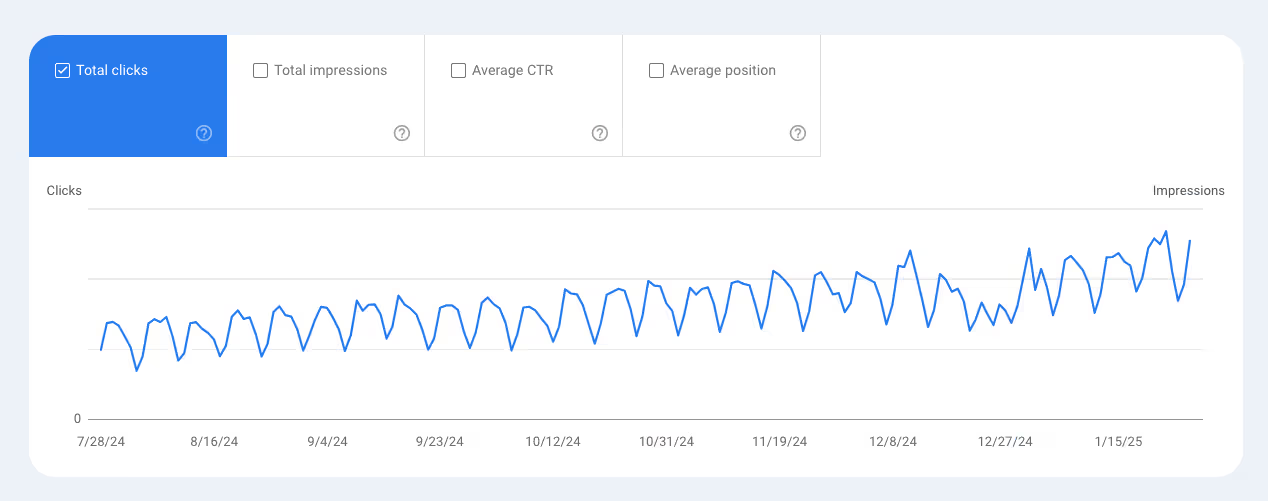Planable helps social media teams plan, create, and collaborate on content across multiple platforms. The platform allows marketing departments to visualize content calendars and streamline approval workflows, making them an essential social media management tool.
When Andreea Stefan joined the company as SEO Lead, she recognized that Planable was leaving significant growth opportunities on the table.
Despite possessing valuable expertise, their content strategy wasn’t prepared to generate organic traffic from search results.
Fast forward to today: they've multiplied content output by 10x, streamlined their SEO workflows, and their traffic graph shows a consistent upward trajectory.

This case study reveals exactly how they did it.
4 roadblocks holding Planable’s SEO back
For SaaS companies like Planable, organic traffic isn't just nice to have – it's a critical acquisition channel.
Each visitor arriving through search represents a potential customer with a specific problem to solve, already actively searching for solutions.
The SEO team at Planable was dealing with 4 challenges.
1. Missing their audience's pain points
Planable's content wasn't comprehensively addressing what their audience was searching for.
Instead of creating articles that directly solved specific social media management challenges, they produced generalized content that failed to connect with searchers' intent.
"Articles were not fully aligned with the specific pain points of their audience. This led to missed opportunities and untapped potential for organic traffic."
– Andreea Stefan, SEO Lead at Planable
2. Keywords competing against themselves
Without a structured SEO framework, Planable found themselves in the classic keyword cannibalization trap. Multiple articles would target similar keywords and intent, forcing their content to compete against itself in search rankings.
For example, articles about "social media scheduling" and "planning social posts" have similar search intent and will dilute each other's potential to rank, despite addressing slightly different aspects of their product offering.
Instead, a single article on “social media scheduling” can rank for both these keywords.
3. Production bottlenecks limiting scale
An alarming issue was Planable's content production capacity: just 3 articles per quarter.
This glacial pace meant they couldn't possibly cover their market's information needs or keep up with competitors publishing weekly content.
Internal resource constraints were the primary reason, but quality control with external writers also held them back.
As much as SEO is about providing useful content, it also requires momentum and decent content coverage.
External writers weren't familiar with their audience, product, or SEO requirements, resulting in content that either needed extensive rewrites or couldn't be published at all.
4. Manual SEO inefficiencies
Every manual optimization task—from keyword research to content structure—required specialized knowledge and significant time from their limited in-house resources—thus slowing them down further.
From 3 to 30 articles: Planable’s SEO plan
After evaluating several solutions, including ClearScope, Planable selected Surfer to transform their content production.
While Plannable briefly experimented with ClearScope, Surfer’s intuitive interface and comprehensive functionality of the Content Editor made it a superior choice.
1. Content that addressed user needs
Planable ensured their content directly addressed specific audience pain points based on where they were in the buyer journey. Articles now matched search intent more precisely, improving both rankings and engagement metrics.
For instance, instead of a general article about "social media scheduling," they created several articles on the topic of social media scheduling, from top-of-the-funnel informational content like “how to create a marketing calendar”–

–to bottom of the funnel templates and comparison pieces.

This helped Andreea and her team address specific challenges that their audience faced.
This is easily accomplished using Surfer’s Topical Map which suggests topical clusters and associated keywords to create a comprehensive content plan.

2. Clear keyword separation eliminated cannibalization
Andreea and her team established clear differentiation between articles targeting related terms to deal with the keyword cannibalization issue.
When creating content clusters around topics like "social media planning" and "content calendars," they could now ensure each piece served a distinct purpose without competing with existing articles.
This minimized the content cannibalization that had previously diluted their search visibility.
To find keyword cannibalization issues on your website, head to Surfer, generate and download the keyword cannibalization report.

For example, I was able to find 12 articles that are cannibalizing traffic to our blog post on how to use Surfer. Fixing these will help direct users to the content that best serves their needs.

3. Standardized processes allowed to scale content
Perhaps most importantly, Surfer enabled Planable to standardize their entire content production workflow.
This standardization facilitated seamless collaboration and bridged the expertise gap between content managers, SEO specialists, and writers.
For example, writers could follow Surfer’s Content Score as a way to measure how well optimized their content was.

Everyone participating in the content process could now maintain consistency and generate content that adhered to Planable's standards.
Planable’s SEO specialists no longer needed to collect and share relevant keywords for writers to include in their content.
Content Editor provided clear guidance on keyword usage, showing writers exactly which terms to include and how frequently they should appear. This eliminated guesswork and ensured content naturally incorporated target phrases without keyword stuffing.
For example, when creating an article about "examples of social media content campaigns," Surfer suggests related terms like "social media marketing," and "effective social media campaigns" – ensuring comprehensive coverage of the topic.

Writers could see in real-time whether their content met SEO requirements, reducing revision cycles and speeding up the approval process.
This eliminated the previous workflow where SEO specialists had to extensively revise writer submissions – a major bottleneck in their production process.
Surfer’s Content Editor became the foundation of Planable's content writing process–providing structured guidance for content writers to produce SEO-optimized content without specialized expertise.
The most dramatic improvement came in content output.
Planable went from publishing 3 articles per quarter to consistently delivering 30 – a 10x increase in production capacity.
The results were immediate: freelancers could now create publish-ready content with minimal supervision.
By removing the SEO knowledge bottleneck, Planable expanded their contributor network while maintaining consistent quality.
4. Automation replaced manual SEO tasks
Before Surfer, Planable's team manually tracked keyword density, heading structure, and keyword prioritization for each article. These time-consuming tasks limited how many pieces they could realistically manage.
Using Surfer’s content platform allowed Planable’s team to scale what were previously manual tasks – like keyword research, website audits and content editing.
Take their content plan for example. Based on their niche, Surfer generated 852 ideas for articles segmented by related topic clusters.

And dont forget about tracking SEO analytics.
Andreea and her team can now use Surfer to make sense of their GSC data without complicated spreadsheets.

Automating previously manual tasks with Surfer dramatically increased what Andreea and her team could accomplish with the same resources.
What once took weeks could now be completed in days.
Planable's remarkable results
Andreea’s strategy’s validation came from Planable’s traffic dashboard, showing consistent growth in clicks from July 2024 through January 2025.

From July 2024 to mid-January 2025, Plannable experienced roughly a 176% increase in organic traffic over these 6 months.
With a clear upward trajectory, the numbers confirm their strategy is working.
Planable isn't resting on their success with their content machine now operating efficiently. They plan to continue leveraging Surfer’s content capabilities.
Lessons for SaaS companies
Planable's experience offers valuable insights for other SaaS companies facing similar content challenges:
AI as a multiplier, not just a tool
The right technology doesn't just improve efficiency – it can fundamentally transform what's possible. Planable didn't just do the same things faster; they completely reimagined their content capabilities.
Process standardization enables scale
Documented, repeatable processes were just as important as the technology itself. By creating standard operating procedures around content creation, Planable unlocked collaboration opportunities that weren't previously possible.
Intuitive tools bridge expertise gaps
The most valuable aspect of Surfer for Planable wasn't the advanced features but its accessibility. Making SEO concepts intuitive for non-specialists eliminated knowledge bottlenecks that had previously constrained growth.
"Surfer has played a transformative role in our SEO journey. By addressing core challenges, automating key processes, and enabling collaboration across diverse teams, it has empowered us to achieve and exceed our content production goals."
– Andree Stefan, SEO Lead at Planable


.avif)